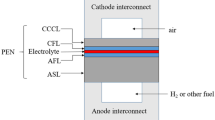Abstract
This study focuses on the research of solid oxide fuel cell (SOFC) and proposes reasonably practical designs, analyses, and numerical analyses with coupling software in physics, COMSOL Multiphysics, as the analysis tool to discuss the effects on the SOFC performance. This research applies the design of electrode support (anode support) to substitute the original electrolyte support, Yttria-stabilized zirconia, so that the electrolyte membrane could form a membrane to reduce ohmic resistance and increase power density. This study further discusses the effects of various flow fields (counterflow and co-flow) on internal mass transfer and SOFC performance. The findings show that the cell performance of SOFC with co-flow is better than counterpart with counterflow under anode support thickness 1,000 μm. Regarding the analyses of porosity effect with the porosity 0.7 and tortuosity 4.5, the power density reaches the maximum that could enhance the cell performance.

















Similar content being viewed by others
References
Achenbach E (1994) Three-dimensional and time-dependent simulation of a planar solid oxide fuel cell stack. J Power Sources 49:333–348
Achenbach E (1995) Response of a solid oxide fuel cell to load change. J Power Sources 57:105–109
Brinkman HW, Briels WJ, Verweij H (1995) Molecular dynamics simulations of Yttria-stabilized zirconia. Chem Phys Lett 247:386–390
YaKabe H, Hishinuma H, Uratani M, Matsuzaki Y, Yasuda I (1999) Evaluation and modeling of performance of anode-supported solid oxide fuel cell. J Power Sources 86:423–431
Yakabe H, Ogiwara T, Hishinuma M, Yasuda I (2001) 3-D model calculation for planar SOFC. J Power Sources 102:144–154
Yakabe H, Sakurai T (2004) 3D simulation on the current path in planar SOFCs. Solid State Ionics 174:295–302
Recknagle KP, Williford RE, Chick LA, Rector DR, Khaleel MA (2003) Three-dimensional thermo-fluid electrochemical modeling of planar SOFC stacks. J Power Sources 113:109–114
Suwanwarangkul R, Croiset E, Fowler MW, Douglas PL, Entchev E, Douglas MA (2003) Performance comparison of Fick’s, dusty-gas and Stefan–Maxwell model to predict the concentration overpotential of a SOFC anode. J Power Sources 122:9–18
Ackman T, de Haart LGJ, Lehnert W, Stolten D (2003) Modeling of mass and heart transport in planar substrate type SOFCs. J Electrochem Soc 150:A783–A789
Aguiar P, Adjiman CS, Brandon NP (2004) Anode supported intermediate temperature direct internal reforming solid oxide fuel cell. I: model-based steady-state performance. J Power Sources 138:120–136
Zhao F, Virkar AV (2005) Dependence of polarization in anode-supported solid oxide fuel cells on various cell parameters. J Power Sources 141:79–95
Hussain MM, Li X, Dincer I (2006) Mathematical modeling of planar solid oxide fuel cells. J Power Sources 161:1012–1022
Wang Y, Yoshiba F, Watanabe T, Weng S (2007) Numerical analysis of electrochemical characteristics and heat/species transport for planar porous-electrode-supported SOFC. J Power Sources 170:101–110
Liu HC, Lee CH, Shiu YH, Yi R, Yan WM (2007) Performance simulation for an anode-Supported SOFC using Star-CD code. J Power Sources 167:406–412
Moussa HB, Zitouni B, Oulmi K, Mahmah B, Belhamel M, Mandin P (2009) Hydrogen consumption and power density in a co-flow planar SOFC. J Hydrogen Energy 34:5022–5031
EG, G Technical Services Inc. (2004) Fuel cell handbook (the seventh edition). U.S. Department of Energy, Morgantown
Naveed A, Stephen PD, Daniel L, Kevin K (2009) A three-dimensional numerical model of a single-chamber solid oxide fuel cell. J Hydrogen Energy 34:8645–8663
Shi Y, Cai NS, Li C (2007) Numerical modeling of an anode-supported SOFC button cell considering anodic surface diffusion. J Power Sources 164:639–648
Patankar SV (1980) Numerical heat transfer. Hemisphere, Washington, DC
Kuo JK (2010) Numerical investigation into thermofluidic and electrochemical characteristics of tubular-type SOFC. Fuel Cells 10:463–471
Acknowledgments
This study was sponsored by the Institute of Nuclear Energy Research under contract no. 992001INER045.
Author information
Authors and Affiliations
Corresponding author
Rights and permissions
About this article
Cite this article
Kuo, JK., Wang, JK. Characteristic simulation with various anode support thicknesses of membrane electrode assembly in SOFC. J Solid State Electrochem 16, 329–340 (2012). https://doi.org/10.1007/s10008-011-1328-5
Received:
Revised:
Accepted:
Published:
Issue Date:
DOI: https://doi.org/10.1007/s10008-011-1328-5




